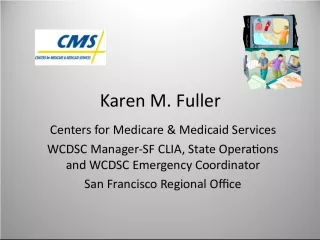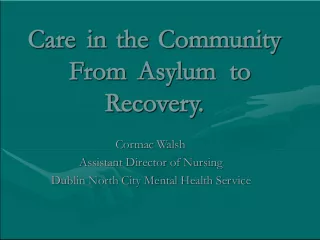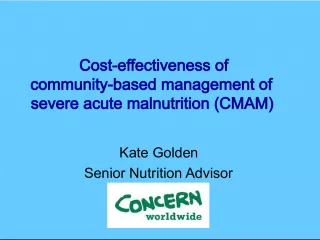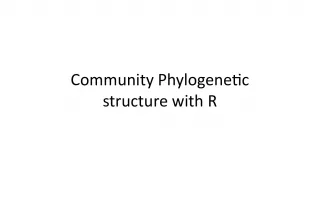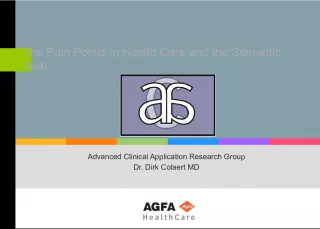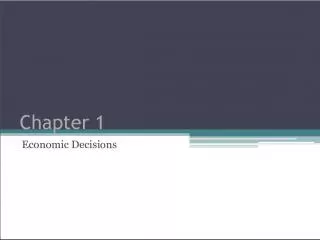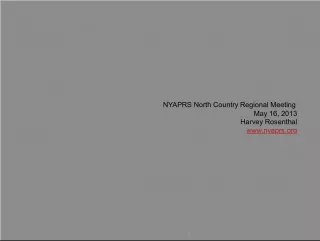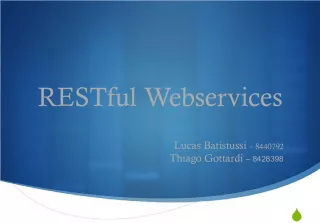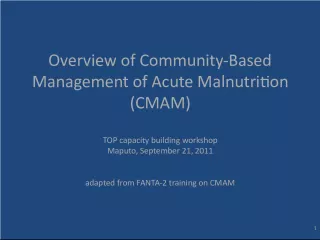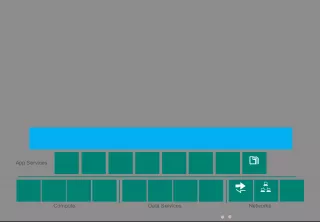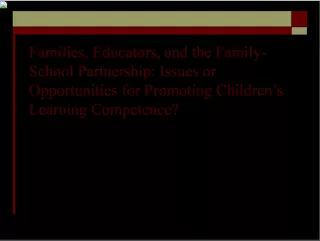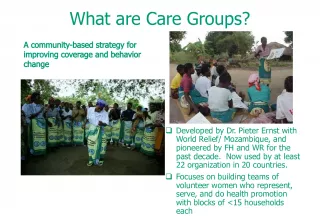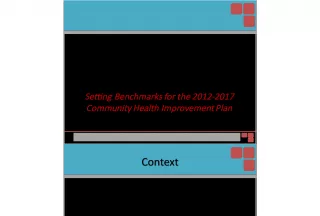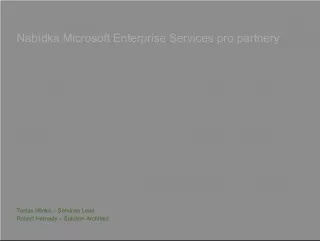Home and Community Based Services (HCBS) Waivers
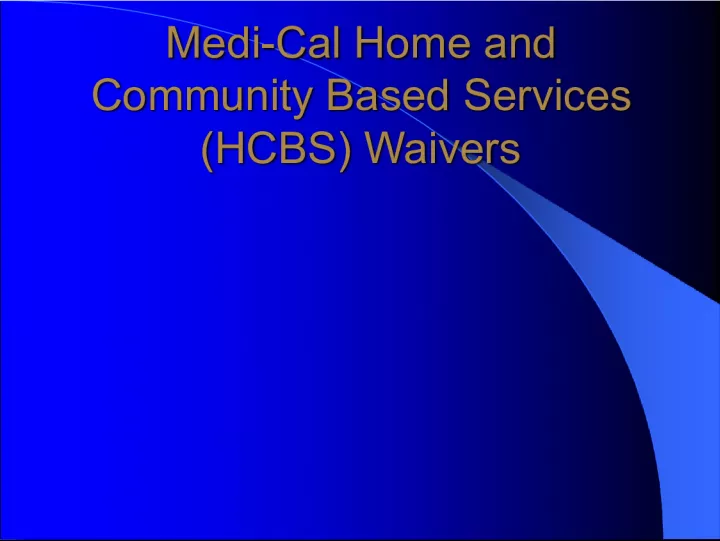

HCBS Waivers provide an expanded scope of Medicaid services to targeted populations and waive certain income and resource rules. This article explains what Home and Community Based Services (HCBS) are and how HCBS Waivers provide increased coverage.
- Uploaded on | 0 Views
-
 egypthickle
egypthickle
About Home and Community Based Services (HCBS) Waivers
PowerPoint presentation about 'Home and Community Based Services (HCBS) Waivers'. This presentation describes the topic on HCBS Waivers provide an expanded scope of Medicaid services to targeted populations and waive certain income and resource rules. This article explains what Home and Community Based Services (HCBS) are and how HCBS Waivers provide increased coverage.. The key topics included in this slideshow are HCBS Waivers, Medicaid services, income and resource rules, Home and Community Based Services, target populations,. Download this presentation absolutely free.
Presentation Transcript
1. Medi-Cal Home and Community Based Services (HCBS) Waivers Medi-Cal Home and Community Based Services (HCBS) Waivers
2. What are Home and Community Based Services (HCBS) Waivers? What are Home and Community Based Services (HCBS) Waivers? HCBS Waivers provide for an expanded scope of Medicaid services to targeted populations. HCBS Waivers also provide an expanded coverage of existing services to target populations who might otherwise be ineligible for Medicaid by waiving certain income and resources rules. While HCBS Waivers waive certain Medicaid rules, they also retain other federal Medicaid principles, such as freedom of choice; reasonable promptness; and due process.
3. What Medicaid rules are waived through HCBS Waivers? What Medicaid rules are waived through HCBS Waivers? Statewideness: Unlike general Medicaid, states can limit services to specific geographic areas within the state under HCBS Waivers. Comparability: Unlike general Medicaid, states can offer more services to target groups the HCBS Waiver is intended to cover. Income/Resource rules: States have the option of disregarding income deemed from a parent or spouse to an individual who would otherwise be ineligible for Medicaid.
4. What is institutional deeming? What is institutional deeming? Persons who have conditions the particular HCBS Waiver is designed to cover, but whose income and/or resources are too high for eligibility when deemed from a parent or spouse, can have this barrier disregarded. Here, the person is treated as if he or she were in an institution which, under Medicaid rules, only considers the persons income and resources. The individuals own income and resources must still fall below the regular Medicaid limits.
5. What is cost-neutrality? What is cost-neutrality? The costs of services provided to persons within the target group in the community under the HCBS Waiver must be cost-neutral when compared to costs the government would incur if the person lived in an institution. This is called cost-neutrality. A HCBS Waiver can be structured to consider individual or aggregate cost-neutrality. Under individual cost- neutrality, the persons community expenses cannot exceed the costs it would take to care for that person in an institution. Under aggregate cost-neutrality, the community expenses of the entire target population cannot exceed the costs it would take to care for the entire class in institutional settings.
6. History of Waivers History of Waivers Before 1981, Medicaid long-term care only funded home health, personal care and institutions. That year, Section 1915 (c) of Social Security Act, the federal law establishing HCBS Waivers, was enacted in 1981 under the Reagan administration. The program design allows States to choose target populations and the scope, number and types of Medicaid services it will offer, so long as the program is cost-neutral. States can choose whether to base their HCBS Waiver programs on individual or aggregate cost-neutrality.
7. Types of Waivers Types of Waivers The types of HCBS Waivers vary from state to state. For instance, there are several states with waivers designed to target persons with traumatic brain injuries. Some states offer HCBS waivers for persons with serious emotional disorders and other states offer Waivers to persons with Alzheimers. California has six HCBS Waivers: AIDS; Multipurpose Senior Services Program (MSSP); In Home Medical Care (IHMC), Nursing Facility (NF) Subacute, NF A/B, and the DDS Waiver.
8. Californias Six HCBS Waivers Californias Six HCBS Waivers AIDS: Administered by the Department of Health Services (DHS) Office of Aids: http:// www.dhs.ca.gov/mcs/mcpd/RDB/DSH/word docs/DSH Web Page Contents/DPU Docum ents/Office of AIDS Medi.html Then click on: Office of Aids Medi-Cal Waiver Program (MCWP) MSSP: Administered by Department of Aging: http://www.aging.state.ca.us/html/programs/mssp.html http:// www.pai-ca.org/Pubs/539501.pdf IHMC, NF Subacute, NF A/B: Administered by DHS In- Home Operations (IHO) DDS Waiver: Administered by the Department of Developmental Services
9. What is In-Home Operations? What is In-Home Operations? IHO is the unit within DHS that oversees the IHMC, NF Subacute, and NF A/B Waivers. IHO also oversees EPSDT Supplemental Services such as in-home shift nursing and pediatric day health care. For more info, see: http:// www.dhs.ca.gov/mcs/mcod/ihos/default.htm http:// www.pai-ca.org/pubs/539901 .pdf
10. In-Home Operations Waivers In-Home Operations Waivers IHO oversees the IHMC, NF A/B, and Subacute (Pediatric & Adult) Over the years, these Waivers have undergone several changes in name and design, i.e. individual vs. aggregate cost neutrality. Currently, IHO Waivers utilize individual cost-neutrality. The determination of which Waiver is appropriate for a recipient is based on level of care determinations under Title 22 regulations and the Medi-Cal Manual of Criteria. Waiver Personal Care Services (WPCS): These are additional IHSS- type services authorized by IHO under these Waivers for adult companion services or unskilled nursing, but they count against ones individual cost cap. Currently, children requiring in-home nursing who age out of EPSDT are automatically guaranteed a slot on one of IHOs Waivers. The main issue that arises here is what Waiver is most appropriate to serve this recipient based on their level of care needs.
11. DDS Waiver History DDS Waiver History The federal government approved Californias DDS Waiver in 1982. The DDS Waiver has undergone 3 renewals since. DHS oversees the quality assurance of this Waiver but because of budget layoffs in 1990-1991 staff were laid off. the federal government. The federal government performed and audit of the DDS Waiver program in 1997 and issued multiple deficiencies. The feds froze the existing population under the Waiver and it took years for California to com pletely come into satisfactory compliance with the feds corrective action plan. More laws, regulations, and a revised DDS Waiver program design resulted from the audits findings.
12. DDS WAIVER DDS WAIVER To be eligible for the DDS Waiver, the recipients level of care must meet the intermediate care facility for the developmentally disabled (ICF/DD). Once eligible, the recipient is entitled to full scope, zero share of cost Medi-Cal, including EPSDT Supplemental Services for persons under 21 years old. The DDS Waiver also allows for PCSP eligibility. Recipients receive an expanded scope of services and expanded coverage of existing services. Recipients are also entitled to Medi-Cal Targeted Case Management from the regional center. If one is denied eligibility for the DDS Waiver, or if one is denied Medi-Cal services under DDS Waiver, the Office of Appeals and Hearings (OAH) has jurisdiction to hear the claims. The decision issued by OAH is only a proposed decision and it should be referred to DHS, where it can be adopted or altered by DHS Director.
